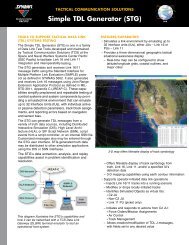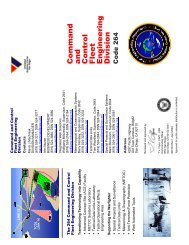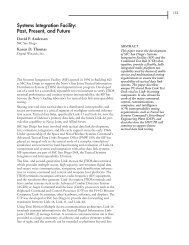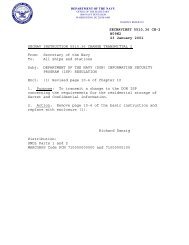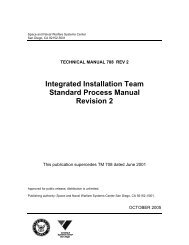Intelligence, Surveillance, and Reconnaissance - Spawar
Intelligence, Surveillance, and Reconnaissance - Spawar
Intelligence, Surveillance, and Reconnaissance - Spawar
You also want an ePaper? Increase the reach of your titles
YUMPU automatically turns print PDFs into web optimized ePapers that Google loves.
140<br />
INTELLIGENCE, SURVEILLANCE, AND RECONNAISSANCE<br />
(Figure 7). This unit is equipped with a GPS waypoint navigation package<br />
<strong>and</strong> controlled by the Multiple-robot Operator Control Unit<br />
(MOCU), both developed at SSC San Diego. In February 2003, this technology<br />
was transitioned to INEEL in exchange for its OD/OA software.<br />
One of the first applications for this combined package running on the<br />
ATRV will be in support of the upcoming Advanced Robotic Behavior<br />
Technology (ARBT) Science <strong>and</strong> Technology Objective (STO) demonstration<br />
in November 2003.<br />
Organic Air Vehicle Mission System<br />
The main project goal is to develop a system that allows a UAV to be<br />
launched, recovered, <strong>and</strong> refueled by a host platform in order to provide<br />
force extension through autonomous aerial response. Some of the nearterm<br />
UAV missions include reconnaissance, radio frequency (RF) communications<br />
relays, overhead visual GPS augmentation, surveillance,<br />
psychological operations, <strong>and</strong> mine detection. Future uses include target<br />
designation <strong>and</strong> payload dispersal (i.e., submunitions). Other benefits are<br />
seen in the mission flexibility that allows the UAV to be launched from<br />
one type of system <strong>and</strong> recovered by another (e.g., launch from an<br />
unmanned surface vehicle <strong>and</strong> recovered by a UGV). Another benefit is<br />
the reduction in time <strong>and</strong> personnel required to refuel a UAV during<br />
mission operations, which thus increases the number of missions a UAV<br />
can complete in a given period of time.<br />
SSC San Diego has worked closely with Allied Aerospace, Inc., to develop<br />
an initial feasibility demonstration system. A prototype launch fixture<br />
was mounted on the MDARS-E vehicle <strong>and</strong> tested with Allied’s 29-inch<br />
iSTAR organic air vehicle (OAV) in March 2002 (Figure 8). Design <strong>and</strong><br />
initial integration of the recover mechanism has been completed, awaiting<br />
the integration with MOCU for recovery control. Engineers at SSC San<br />
Diego will exp<strong>and</strong> on <strong>and</strong> prototype the initial design <strong>and</strong> model of the<br />
refueling system developed by mechanical engineering students at the<br />
University of California, San Diego.<br />
Projected users include the Cooperative Unmanned Ground Attack<br />
Robot (COUGAR) program, the DARPA Perception for Off-road<br />
Robots (PerceptOR) program, Naval Special Warfare Group 3, <strong>and</strong> the<br />
Counter Mine Science <strong>and</strong> Technology Objective (CM STO).<br />
Opportunities for collaboration with other government agencies <strong>and</strong><br />
publication of lessons learned <strong>and</strong> design processes will also be pursued<br />
as part of this project.<br />
FIGURE 7. Exterior transition platform,<br />
iRobot ATRV.<br />
FIGURE 8. MDARS-E vehicle with launch<br />
fixture for the 29-inch iStar OAV.



